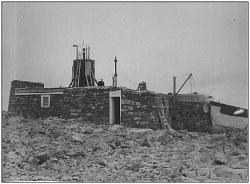Women in the Race
Up until the turn of the century women were banned from the race, but in 1902 Lucy Cameron of Glen Mallie made the attempt and achieved a time of 2 hours and 3 minutes - just three and a half minutes more than the current record. The new attempt on the lady's record saw Elizabeth Tait, the post runner at Corrour, achieving a record time of 1 hour, 59 minutes and 30 seconds. This record stood for some time. The race retains its historic charm, and even today Ben Nevis literature refers to women as 'lady runners' rather than 'female runners'.
The Rise and Fall (and Rise) of the Ben Nevis Race
The last of the timed races was in 1903 and Robert Dobson of Glasgow took part. Dobson was found unconscious on the pony track by a tourist. Rescuers were called from Fort William, and they had to carry the still unconscious Dobson down the mountain. He remained unconscious until 2 o'clock the next morning but was able to catch the train home early in the afternoon. He was diagnosed with 'over-exertion and heart strain' at the time. The races were halted after that, but records are not clear on whether it was connected with Dobson's collapse, or whether it was the closure of the Observatory in 1904.
No records remain of any other timed runs up until 1937 but the impulse to get to the top of Ben Nevis continued. Timed challenges again began, and the event grew to become a full blown race with the backup and organisation that that involves. By 1942 it was well established attracting spectators who would line the route and the start and finish points. For hill runners, the Ben Nevis Race is one of the greatest events of the year and attracts interest and participators from all over the world. There was a seven-year break after 1944, but the has continued ever since save for the exceptional year in 1980 when the weather caused the cancellation when walkers were at the start line. In 1957 was the first and only death during the race - that of John Rix, who died from hypothermia. He lost a shoe in the Red Burn and had not stayed on the mountain path, so it was nine hours before rescuers found him. He was still alive when found, but died being carried down the mountain.
The interest in the race grows bigger year by year, and it's doubtful that it will wane anytime soon. So if you've walked up Ben Nevis and thought you might be able to do better, you could start getting in some practice now! But remember one thing:
This is not a race for novice walkers!

Join us on
Please visit the Sitemap to see the full range of information on this site
MountainWalk.co.uk is produced by Trish Haill Associates Copyright
Have you climbed Ben Nevis, Snowdon or Scafell Pike? Or taken part in the Three Peaks Challenge? Or have a special walk you'd like to share? We'd love to here from you! Join us on
or Send us an email.
or Send us an email.
Ben Nevis Race
Annual Ben Nevis Race
The annual Ben Nevis Race is held on the first Saturday in September. Places are limited and quickly filled.
The Ben Nevis Race commenced in its present form in 1937 and is held on the first Saturday in September. The starting and finishing points are at the Claggan Park Football ground. The race is 9.9 miles long and climbs the full 1,340 metres (4,400 ft) height of Ben Nevis. Runners can take any route they like up and down the mountain so may run more than the official length.
A maximum of 600 competitors can take part. The mountain environment is not to be taken lightly, so all those in the race must have already completed three of the toughest hill races. Runners must carry waterproofs, a hat, gloves and a whistle, and runners can be turned back if they have not reached the summit in 2 hours.
The record was set in 1984 when Kenny Stuart and Pauline Haworth of Keswick Athletic Club won the men's and the women's races with times of 1 hour 25 minutes and 34 seconds, and 1 hour 43 minutes and 25 seconds respectively.
History of the Ben Nevis Race
The race is a supreme test of athletic fitness.
The first timed ascent up Ben Nevis took place in 1895, by William Swan, a hairdresser from Fort William. He ran from the old post office in Fort William, and Swan made the summit and back in 2 hours 41 minutes. The first competitive race was held in 1898.
After the hotel and observatory were built on the summit of Ben Nevis and the train line was extended to Fort William there was increased interest in the mountain and getting to the top. In 1894 more tourists came to walk to the top of the highest mountain in Great Britain as the train line was extended to Fort William. Sometimes 'as many as 30 to 40 a day'. Now it was not just a question of whether it was possible to get to the top, rather it was how quickly the ascent could be made.
The first timed ascent up Ben Nevis took place in 1895, by William Swan, a hairdresser from Fort William. He ran from the old post office in Fort William, and Swan made the summit and back in 2 hours 41 minutes. The first competitive race was held in 1898.
After the hotel and observatory were built on the summit of Ben Nevis and the train line was extended to Fort William there was increased interest in the mountain and getting to the top. In 1894 more tourists came to walk to the top of the highest mountain in Great Britain as the train line was extended to Fort William. Sometimes 'as many as 30 to 40 a day'. Now it was not just a question of whether it was possible to get to the top, rather it was how quickly the ascent could be made.
William Swan was the first to make a timed ascent, but he was followed by many others. The arrival of the runners was a welcome diversion to those manning the observatory. On race days the meteorological staff were 'all agog with excitement, the man of the night watch even foregoing his quota of sleep to watch the competitors arrive and depart'.

Observatory on the top of Ben Nevis
Other pages you might like:
Climbing Ben Nevis
Hiking Equipment
Fitness levels required
How to get to Ben Nevis
Where to stay
Facts and History
Walking in the Highlands
Climbing Ben Nevis
Hiking Equipment
Fitness levels required
How to get to Ben Nevis
Where to stay
Facts and History
Walking in the Highlands
The race is a gruelling one, only suitable for people over the age of 18, who are members of a bonafide Athletic Club and who have completed three Category 'A' hill/fell races.
If you are walking the mountain track and see someone running past you, they are probably getting in some practice. A novice walker will reach the summit in three and a half to five hours - racers reach the top in around an hour!
If you are walking the mountain track and see someone running past you, they are probably getting in some practice. A novice walker will reach the summit in three and a half to five hours - racers reach the top in around an hour!
